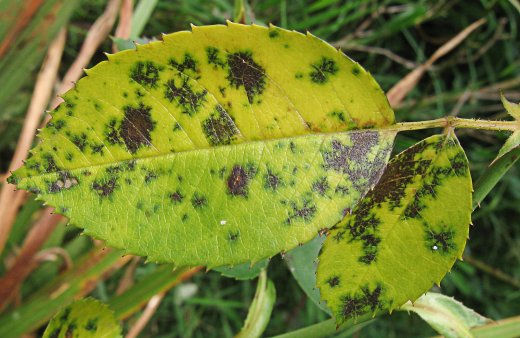SYMPTOMS OF ROSE BLACK SPOT
The symptoms of rose black spot are as follows:
- When the leaves start to fully form (normally around mid April in the UK) you will notice small, dark purple spots on them.
- As the leaves develop, the black areas increase in size, some joining together.
- The remaining green parts of the leaves gradually turn yellow.
- Leaves eventually fall off prematurely.
- You may notice black spots on the stems.
The picture below illustrates the symptoms.

![]()
Symptoms of rose black spot
HOW TO TREAT ROSE BLACK SPOT
Without a shadow of doubt, prevention of rose black spot is the best course of action. When the fungus has taken hold it is difficult to cure. Repeat the instructions give below each year. The key steps in the prevention of rose black spot are summarised below. Each step is then described in more detail further down this article. The initial stages of preventing rose black spot can be conveniently done when you prune your rose bush.
- In late February to early March place a layer of cardboard or paper around the plant.
- Cover the cardboard or paper with a mulch such as wood chip, compost or even grass clippings.
- In mid to late March start to spray the plants with a rose black spot spray.
- Repeat the spraying at the intervals described on the packaging of the product you are using.
- If your roses need watering, water the soil not the plant. Water on rose leaves encourages black spot.
- Clean up leaves if they fall off and remove infected leaves from the plant
MULCH WITH CARDBOARD OR PAPER
Almost all rose bushes will have some degree of black spot and when the leaves drop in winter some will be infected. Before laying any mulch pick up as many leaves as you can and burn them.
Inevitably there will be some that you miss and it is these which will be a source of infection during the next growing season. See the life cycle diagram below of rose black spot to understand more about this fungal infection.

![]()
The aim of mulching the soil around the rose bush with cardboard (or five layers of newspaper) is to trap any remaining leaves where they are. The spores on fallen leaves re infect the plant when rain drops falls on the leaves and the spores splash onto new growth. A layer of cardboard will prevent this happening.
As well as trapping the leaves onto the soil surface, the cardboard will help retain moisture in the soil below. Over the year it will also rot down and provide a small amount of fibre for the soil.
Rose black spot spores can also be blown onto your roses from nearby plants, however there is no method to prevent this. Keeping your roses well fed, well watered and correctly pruned is your best defence.

![]()
MULCH ON TOP OF THE CARDBOARD
The layer of cardboard will simply be blown away if a second layer of mulch is not placed on top of it. This second layer of mulch can be any organic matter which is available to you.
We personally use wood chip which we have free access to. Alternatives include material from your compost heap or chipped bark.
If none of those are available, lawn clippings make an excellent alternative. The layer of cardboard below will prevent all but the most determined weeds from rooting. Grass clippings especially will rot down quickly so you will need to reapply a few times as you mow your lawn.
Not only will this second layer of mulch (whatever it is) hold down the cardboard but it will also trap in more moisture into the soil. It will in time rot down providing fibre and low level nutrients for the soil.
ROSE BLACK SPOT SPRAY
Spraying your roses with an approved fungicide for rose black spot will further reduce the spread of black spot. You will need to make up your own mind if you believe or not that they affect the environment and / or insects.
If you do spray your roses against black spot read the container instructions very carefully and apply the spray as they suggest. I would stress however that the spray is much more effective if you begin spraying early in the season. A first spray in mid to late March is one of the keys to success.
Some sprays for rose black spot also contain an insecticide. Unless your plants are suffering from insects do not use the combined sprays. They are more likely to damage beneficial insects such as bees.
Recommended Rose Varieties for Small / Medium Gardens
Planting a Rose Bush
Caring for Rose Bushes
Prunining Rose Bushes
Propagating Rose Bushes from Hardwood Cuttings
Pests and Diseases of Rose Bushes
Comparison of online rose suppliers
ROSE BLACK SPOT
By David Marks
Rose black spot is the most common problem with roses in the UK. It disfigures the leaves and lowers the shrubs overall strength.
It is caused by a fungus called Diplocarpon rosae. The key to fighting this fungal infection is to understand its lifecycle. See the lifecycle diagram further down this article.
When you understand the lifecycle of black spot the various methods to avoid it become almost common sense.